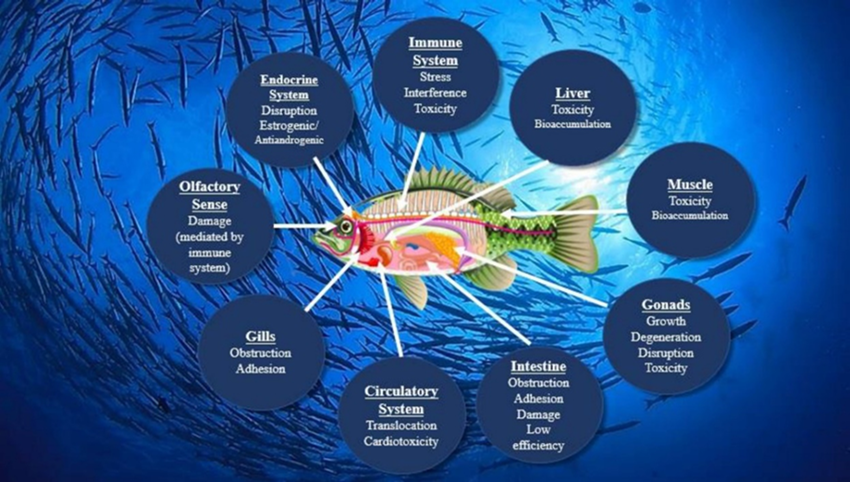
Plastic pollution is globally recognised as an environmental issue with decades of poor waste management leading to the mass amounts of plastic pollution in the world’s oceans.⁴ In 2010, it was estimated that eight million tons of plastic entered the ocean, a statistic that has now almost doubled, with microplastics making up a large proportion of this pollution.⁵ Microplastics are one of the largest rising pollutants of the 21st century as due to their increasing presence in water bodies such as, lakes oceans and seas is growing leading to health risks of marine environments and aquatic organisms.³
What are Microplastics?
Microplastics are minuscule pieces of plastics which range in size from microscopic to 5mm and can be grouped into three different categories: primary, secondary and microfibres. Primary microplastics, also called nurdles, are manufactured products such as microbeads in toothpastes, skin care scrubs and washing powders.¹ Secondary microplastics are particles that have broken down from larger plastic products such as straws, plastic bags and bottles, through degradation from exposure to UV oxidisation, and fragmentation from rapid water movements and abrasions along substrates.⁵ These secondary microplastics continue to breakdown until they are invisible to the naked eye, yet remain in the environment. Microfibres, which are also invisible plastic particles are synthetic fibres which are shed from synthetic fabrics such as polyester from shirts. ¹
How are Microplastics Entering Oceans?
Research suggests that 80% of all plastic pollution in marine ecosystems begins in terrestrial environments with 1.5 million tons of primary microplastics entering the marine environment globally each year.⁵ In South Australia, microplastics are transported into ocean environments via rivers and freshwater catchments, stormwater runoffs, atmospheric transport, and discharge from wastewaters.⁴ With freshwater streams being one of the main contributors of microplastic pollution entering oceans.⁵ Microplastic pollution is correlated with human population and anthropogenic activities and is expected to increase in highly populated cities. An example of how anthropogenic activities increase the amount of microplastics entering oceans is through greywater from household washing machines which can release up to 1,900 microfibres from a single garment during a single wash cycle. Another example of microplastics entering ocean environments is through sand recycling. When sand is transferred, embedded microplastics from one location are transported to another and due to being upturned can re-enter the coastal waters. ⁴
What is the Harm of Microplastics?
There is an estimate of 5 trillion microplastic particles in the ocean worldwide ranging from sediments in the ocean seafloor to the open waters off the coast of the Great Australian Bight.⁴ As microplastic pollution is associated with the human population, high concentrations of microplastics are generally found near urbanised areas due to the plastics entering oceans from rivers and other land-based sources, yet remote locations can also have high microplastic concentrations.⁵ While the South Australian coastline has a low population density compared to other global coasts the concentrations of microplastics are low to moderate.⁴ The South Australian coast is a global biodiversity hotspot with many endemic species and contains an environment that is sensitive to changes. Coffin Bay supports an ecosystem that is more diverse than the great barrier reef and Point Lowly in Whyalla is the only known breeding ground of the Northern Spencer Gulf subspecies of Giant Cuttlefish (Sepia apama). ⁴ These diverse and endemic ecosystems are likely to see detrimental effects from increasing microplastic concentrations as microplastics directly affect marine life as well as marine environments shown in figures 1 and 2 below. ³

Figure 1: The impacts of microplastics on aquatic organisms once ingested. (Image taken from Gola et al. 2021).

Figure 2: The pathway of plastics and microplastics entering oceans and the adverse effects on aquatic life and how it impacts humans. (Image taken from Gola et al. 2023).
Microplastics are ingested by fish, including zooplankton, the smallest animal, due to the small size of the plastics being hard to see in ocean water. Once ingested, microplastics result in many health problems such as liver damage, blockage of body tracts and reduced fertility. ³ Along with harming fish and small aquatic organisms, microplastics are also ingested by larger aquatic organisms and even humans when we consume contaminated seafood. ²
Are there any Solutions?
Fighting against a microscopic plastic that has already entered the ocean seems impossible, however correct plastic waste management can help with microplastic reduction. Banning single use plastic products and products that contain microplastics such as beauty products with microbeads will also help reduce the amount of plastics produced.¹ Stricter policies on plastic use that apply to large industries and the public can help to implement less plastic ending up as waste which will hopefully result in a healthier ocean environment and improve human health.³
References
1 Australian Marine Conservation Society 2023, Microplastics, Australian Marine Conservation Society, viewed 10 May 2023 https://www.marineconservation.org.au/microplastics/.
2 Cox, KD, Covernton, GA, Davies, HL, Dower, JF, Juanes, F & Dudas, SE 2019, ‘Human Consumption of Microplastics’, Environmental Science & Technology, vol. 53, no. 12, pp. 7068–7074.
3 Gola, D, Tyagi, PK, Arya, A, Chauan, N, Agarwal, M, Sing, SK & Gola, S 2021, ‘The impact of microplastics on marine environment: A review’, Environmental Nanotechnology, Monitoring & Management, vol. 16, no. 100552.
4 Klein, JR, Beaman, J, Kirkbride, KP, Patten, C & Burke da Silva, K 2022, ‘Microplastics in intertidal water of South Australia and the mussel Mytilus spp.; the contrasting effect of population on concentration’, The Science of the Total Environment, vol. 831, pp. 154875–154875.
5 Leterme, SC, Tuuri, EM, Drummond, WJ, Jones, R & Gascooke, JR 2023, ‘Microplastics in urban freshwater streams in Adelaide, Australia: A source of plastic pollution in the Gulf St Vincent’, The Science of the Total Environment, vol. 856, pp. 158672–158672.